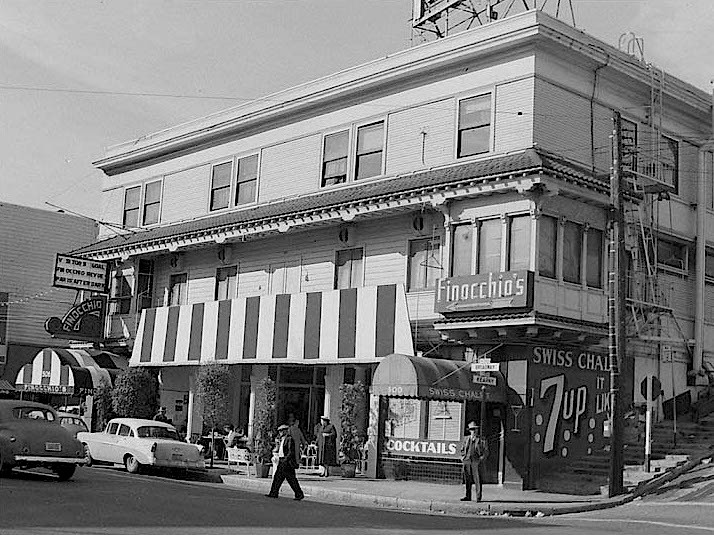Finocchio's (1933-1999)
Introduction
Text-to-speech Audio
Images
Finocchio's Club in 1958

Backstory and Context
Text-to-speech Audio
San Francisco has a long history as a “wide open town,” a place where anything goes. Lying out on the edge of the North American continent, in many ways the city has embraced this image throughout its roughly 200-year existence. At the same time, the history of San Francisco is also a story of repeated anti-vice campaigns and crackdowns against this tendency. Ironically, though, news of these crackdowns often brought even more notoriety to San Francisco’s tendency towards licentiousness, become an integral part of its appeal to tourists. Within this fraught climate, queer culture emerged in the San Francisco of the mid-twentieth century, particularly in its bars, taverns, and nightclubs.
The popular narrative places the 1969 Stonewall Riots in Greenwich Village, NYC at the start of the modern gay rights movement. Yet Stonewall “did not function as a mobilizing factor in San Francisco’s queer social history…In fact, many of the demands articulated through the Stonewall Riots had already been addressed in San Francisco by 1965” (Boyd, 10). By the mid-late 60s “the queer communities that had evolved through the 1930s, 1940s, and 1950s had acquired both the ability to negotiate directly with police, civic leaders, and lawmakers and the ability to work together as a coherent social and political constituency” (Boyd, 6). This story of how LGBT San Franciscans successfully fought to carve a space for themselves in their city begins around 1933, at the former home of Finocchio’s nightclub.
Originally opened as a speakeasy in 1933, it became a famous venue for female impersonator performances, which early on caught the attention of the police. The bar was raided in 1936, but in an illustrative tale, following the raid, the club relocated to this much larger location at 506 Broadway from its original Stockton Street home and became even more of an integral spectacle to San Francisco tourism. Police action often brought notoriety to establishments that made them even more appealing to tourists and thus essential to maintaining the city’s reputation.
Similarly, during World War II, Finocchio’s was one of many bars to be shut down or set as “off limits” to military personnel, until the owner Joe Finocchio agreed to limit liquor sales to military personnel. Rather than having the effect of suppressing or eliminating gay establishments, ironically these “periodic crackdowns…helped [them] to evolve as new bars opened and closed, grew in number, and became more specialized” (Bérubé 126). It is a cycle of rebirth, evolution, and relocation that would continue over the coming two decades.
Finocchio’s and other like clubs flourished in particular due to the exotic, racialized nature of many of its performances, “capitaliz[ing] on the sexualization of both gender transgression and racial difference” that was becoming more and more part of San Francisco tourism (Boyd 54). The combination of transgender and racialized entertainment now at the forefront of tourist industry “established a liminal public space for gay bars to emerge. Clubs like Finocchio’s legitimized queer entertainments, and bars featuring female impersonators became a standard in gay male culture” (Boyd 56). It remained in operation until 1999.
Sources
Bérubé, Allan. Coming Out Under Fire : The History of Gay Men and Women in World War Two. University of North Carolina Press, 2010.
Boyd, Nan Alamilla. Wide-Open Town: A History of Queer San Francisco to 1965. University of California Press, 2003.
https://en.wikipedia.org/wiki/Finocchio%27s_Club
